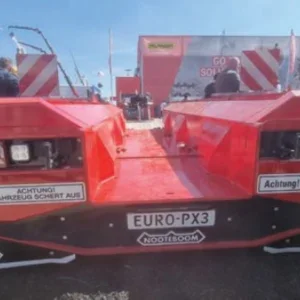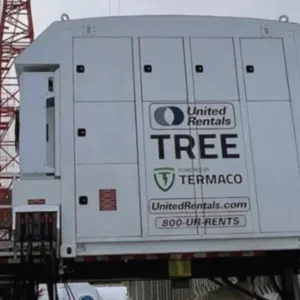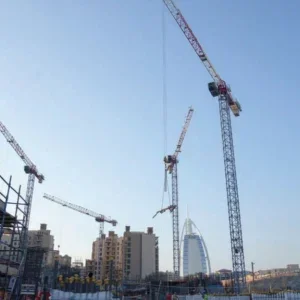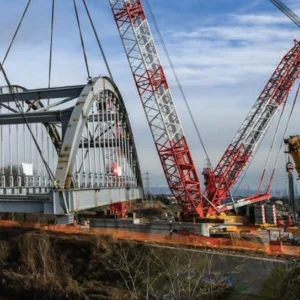With much being reported in the international press regarding the economic turmoil in Dubai (‘Clamour for payment for emirate’s cranes’, Financial Times, January 2010; ‘Arab Emirates move to limit crisis in Dubai’, New York Times, November 2009) there was plenty to discuss for attendees at Middle East Cranes 2010, the fourth annual crane industry conference organised in Dubai by Cranes Today.
Where are the opportunities? Will business return to the levels seen in 2008? How will the market develop in the future?
Much of the emphasis was placed on stressing the work on offer in neighbouring emirate Abu Dhabi and the nearby Kingdom of Saudi Arabia.
Speaking during the panel discussion at the end of the first day, David Semple, managing director of Manitowoc in the Middle East, said: “We have seen very, very exceptional years in Dubai, 2007, 2008. I don’t believe the construction industry in Dubai will ever come back to those levels. I think it will take a very, very long time for confidence to come back to the Dubai market. Does that mean construction is finished for us in the Middle East? Absolutely not.
“Abu Dhabi is picking up. Saudi Arabia is clearly where we see the centre of gravity of the Middle East construction industry moving forwards. For me, Dubai, clearly, is no more an area of focus. It is a great logistical place to be based in, to attract people and to retain people. Providing we are able to be agile and to send them around the Middle East and try to sell to our markets and customers.”
“Dubai is a great entry point, it’s a gateway to the Middle East,” said Masroor Malik, general manager of Saudi Arabian oil and gas company Al Suwaidi, and another speaker on the panel discussion. “It provides an opportunity to experiment and experience the Arabic way of industrialisation.
“Most of the cranes that were in [Dubai] are now either in Saudi Arabia, in Qatar or in Kuwait. Instead of one city, one place or one country, they are all over the region. There are still opportunities and a market, but over a larger geography.”
During his presentation, Eric Etchart, president and general manager of Manitowoc Cranes, reiterated this: “The Middle East continues to be a good market. Saudi Arabia is bringing business, Abu Dhabi as well.
“There has been a business shift from the UAE to Saudi Arabia. There are more large projects in Saudi in the education, health and transport sectors.”
Saudi Arabia
“There are three main questions to ask,” said Malik during his presentation earlier on day one. “Where has been less affected? Which areas are the most prosperous? Why?
“GCC countries have been less affected as funds are still available, they are relatively stable countries, there are development plans and there are large quantities of untapped resources.
“The Kingdom of Saudi Arabia has huge potential as the large size of the country and its markets mean it has the economy to be large.
“Saudi programmes will grow opportunities. The government is driving projects and making it work. It is a ‘say-do’ culture.”
The Princess Noura bint Abdulrahman University for Women in Riyadh is one of the projects in Saudi Arabia that Malik, and Peter Schiefer, CEO, Wolffkran, drew attention to. The university is expected to cover eight million sq m, and will include administration buildings, 13 faculties, a 700-bed student hospital, laboratories, research centres and a residential area that includes accommodation for students and staff. The capacity of the university is around 26,000 students. Schiefer described the university as “a mega project, involving many cranes from many companies”.
Malik also highlighted the King Abdullah Economic City (KEAC) and the KEAC Sea Port, which is planned to be the biggest in the world; Jazan Economic City; a new east to west railway; as well as refineries, gas field developments and construction projects that Malik said amount to around $350bn.
“In 2010, Saudi Arabia looks in good shape. Growth is to happen over coming years as the recovery happens.
“Saudi Arabia is the most attractive market for investors, who recognise the growth potential. Economic cities are being built, and the country is focusing on industries where it can take an international lead.”
Abu Dhabi
Tony Haddad, managing director of Al Jaber Heavy Lift and Transport, Mafraq, and keynote speaker on the opening day, highlighted Abu Dhabi’s Masdar City in his presentation.
The lifting industry faces a number of environmental challenges, along with the rest of the world, Haddad said, and Abu Dhabi is taking a lead in addressing these. The Masdar City project is being touted as the world’s first carbon neutral city, and is described as ‘the future of Abu Dhabi and the future of the world’. The goal of the project is the ‘focussed search for solutions to the issues that challenge our very survival: energy security, climate change and innovation in sustainable technology’, according to official documentation, with Abu Dhabi making investments in renewable energy and sustainable technology industries throughout the development.
“Middle East solutions affect every one of us,” said Haddad. “Environmental issues are the most discussed topics today. There are moves to protect the environment as we must preserve the environment for future generations.”
The Zayed Future Energy Prize is another step forward from the UAE to addressing global environmental challenges. The annual award celebrates achievements that reflect innovation, long-term vision and leadership in renewable energy and sustainability. “There is a commitment from the UAE to the environment,” Haddad said.
Abu Dhabi is moving forward with other projects that present an opportunity to create business and cultural destinations, including Saadiyat Island, the Al Raha Beach project, the Etihad Towers and further growth of Khalifa City. Saadiyat Island is to be a multi-faceted destination, offering residential and commercial locations, a nature reserve, marina, lagoon and its own cultural district.
The latter will include developments by the Louvre and Guggenheim museums, as well as a performing arts centre and the Zayed National Museum, honouring the late leader of the UAE, Sheikh Zayed bin Sultan Al Nahyan.
Work at Al Raha Beach aims to create a mixed-use waterfront city within Abu Dhabi, including residential, commercial and entertainment prospects. The Etihad Towers project is a further mixed-use development measuring 460,000 sq m in size and composed of five towers from 53 to 77 floors, a large multi level podium and four-level underground parking with a capacity for more than 3,200 cars.
Khalifa City is a residential suburb of Abu Dhabi and is divided into three areas: Khalifa City A, Khalifa City B and New Khalifa City. All of Khalifa City is currently being developed, and it is set to rival Dubai’s established Sheikh Zayed Road and become the new city centre of Abu Dhabi.
Wolffkran’s Schiefer said the Middle East and GCC countries are a financial powerhouse, and although Dubai was over leveraged (“it is now grounded,” he said), the fundamental basis, philosophy and ideas remain intact. He highlighted $1.35tn of civil building projects currently active in the Gulf.
“There are opportunities to move forward in the next 20 years,” he said. “The Middle East will be dominant on a global basis. It will become self-propelling with governments as a driving force.”
Driving force
Power, Schiefer added, will continue to be the key growth area across the world as populations grow and countries are forced to invest in power production to avoid shortages. Saudi Arabia for instance, he said, faces power outages of up to five hours per day in the industrial zone of the commercial hub of Jeddah, and is now looking at building its first nuclear power plant in a civilian nuclear energy cooperation with France.
“Growth in populations is driving demand for infrastructure and energy in all markets,” said Etchart. “Energy needs for the Middle East are predicted to rise 30% by 2030. There will be nuclear growth as well. Oil and gas prices are stabilising so projects are coming back on track. There is huge potential.”
Schiefer said future work would appear in different locations to what has gone before in the Middle East, and will see bigger and taller projects that demand highly efficient and reliable crane solutions to reduce costs and time.
This will bring additional benefits to the Middle East crane market, such as increased safety. “There was a gold rush mentality in the boom. Nobody cared about much, with any equipment of any age used to get the job done.
“Future specifications are changing with more demands on efficiency and safety. You can’t cut corners when it comes to crane safety,” Schiefer said.
Safety was addressed in a number of ways at Middle East Cranes. The Crane Safety Forum, launched at the first Middle East Cranes in 2007, was given a platform during the second day, and addressed the issue of load testing cranes to 125% and how industry professionals, both end users and inspectors, should proceed when it comes to making sure lifting equipment is fit for purpose according to the prevailing local regulations. Ralf Ressel, director of research and development, Terex, responded by saying manufacturers are adverse to their equipment being regularly overload tested beyond the maximum capacity, but cannot stipulate this to users as they are bound by regional regulations that require this level of testing.
This linked back to an earlier comment by Eric Etchart, and a recurring theme at Cranes Today events, that the industry faces the continued challenge of achieving global standards.
“Standards vary on many markets,” said Etchart. “There is too much fragmentation. The challenge for manufacturers is to match standards from around the world, so we want to see global standards; a one-size-fits-all approach.”
“The challenge for the market is to produce common denominator systems,” said Terex’s Ressel. “That is the hard part and we hope for standardisation soon but it will take time.”
Safety through training was the central theme for Francois Meiring, training and career development manager, Al Jaber Group; Graham Brent, executive director of the NCCCO in the US; and Manar Shami, project management and technical training, CCC.
Meiring said local governments are again acting as the driving force behind developments in training, with a push to develop a national qualification framework (NQF) helping to improve safety and health awareness, fill knowledge gaps, improve the skills and morale of staff, and, as a result, improve the productivity, efficiency and quality of a company’s output.
The NQF offers a structured approach with logical steps and pathways, said Meiring, allowing career development across the industry. The NQF will also allow the skills of long-term employees who have an established knowledge base earned over many years to be tested and certified. “We need to set pathways and ensure there is the right environment for training and development,” Meiring said.
CCC’s Manar Shami said the key to success in the future is juggling the cyclical nature of the construction industry with an agile business model. The changing nature of business means knowledge has a short shelf life, Shami said, and, as such, CCC must prepare future leaders now by training them from awareness of issues through understanding and application to mastering their trade.
Graham Brent took the opportunity of presenting to the audience at Middle East Cranes to promote the work of third-party certification schemes in helping improve safety. “Training is only effective if the learning is verified,” Brent said.
Joined on stage by Anthony Mitchell, president of the International Assessment Institute, Brent highlighted the safety, development and reputation benefits of operator certification to the lifting industry, and how NCCCO [the National Commission for the Certification of Crane Operators] worked without federal requirements to establish a valid national testing and certification scheme that would satisfy the industry, and health and safety regulators in the US.
“We didn’t want to wait for the federal government to give us something we couldn’t use so we got in first and OSHA [the Occupational Safety and Health Administration] took it on,” Brent said. The programme is designed to be voluntary for industry, but 12 US states are now using the programme or have taken it as a template.
NCCCO is now receiving enquiries about its programme from the Gulf, Brent added, and is in discussions with training providers and other organisations across the region to bring these to fruition. “We are open for business,” he concluded.






